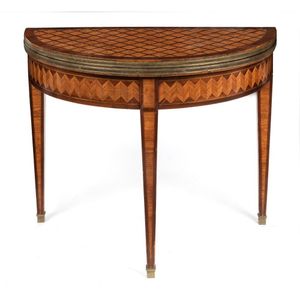19th Century Demi-Lune Parquetry Games Table with Inlaid Design
A demi-lune parquetry inlaid foldover games table, 19th century, with a bold lattice surface and chevron motif to the skirt, opening to green baize interior, supported on a pull out drawer leg, with gilt bronze sabots, 76.5 cm high, 95.5 cm diameter
You must be a subscriber, and be logged in to view price and dealer details.
Subscribe Now to view actual auction price for this item
When you subscribe, you have the option of setting the currency in which to display prices to $Au, $US, $NZ or Stg.
This item has been sold, and the description, image and price are for reference purposes only.
- Foldover - A term used when describing card, tea or games tables, where the top folds over onto itself when not in use. The interior surfaces that are exposed when the top is open may be polished (in the case of tea tables) or baized (for card or games tables).
- Chevron Motif - In jewellery, a chevron is a V-shaped pattern or design that is often used to create a bold and striking visual effect, and as a symbol of strength, power and protection.. It is a classic motif used in many different styles of jewellery and can be seen in various forms such as on a ring, earrings, bracelets, and necklaces. It can be created with precious or semi-precious stones, pearls, or enamel. It can be found in different forms such as engraved or inlaid or beaded.
In ceramics the pattern is often used in decorative pottery and porcelain pieces, such as vases, bowls, plates and figurines. The chevron pattern can be created by using different colored glazes or by hand-painting the design onto the piece. It is also commonly found in the form of embossing or intaglio in decorative ceramic objects. This pattern can be seen as a popular design choice in Art Deco and Art Nouveau style of ceramics.
This chevron pattern can also be found in many different types of furniture, such as tables, chairs, chests of drawers, and cabinets. A common place to find chevron pattern is in a herringbone pattern, which is made up of repeating V-shaped patterns. The chevron pattern can be created by using different types of wood, inlaying or by using different colors of stain. It is also commonly found in the form of a veneer. This pattern can be seen as a popular design choice in mid-century modern, Art Deco, and contemporary style furniture. - Baize - Baize is a type of fabric that is made from wool or a wool blend. It is a dense, closely-woven fabric that is smooth to the touch and has a matte finish. Baize is often used for covering surfaces, such as table tops or the playing surface of card, pool and billiard tables, and for lining drawers and boxes, because it is durable and resistant to wear. This fabric is often associated with gambling and is often used on casino gaming tables and other gaming equipment.
- Parquetry - Parquetry is inlay laid in geometric patterns, the contrast being achieved by the opposing angles of the grain and veneers. The herringbone pattern is the most commonly used in flooring, but this is almost never seen in furniture - the patterns used are more complex and unlike flooring, can include several different varieties of timber.
- Inlay - Decorative patterns inserted into the main body of a piece of furniture, generally in wood of contrasting colour and grain, though brass, ivory, ebony, shell and sometimes horn have been used. Inlay may consist of a panel of well figured timber inset into a cabinet door front, geometric patterns, or complex and stylized designs of flowers, swags of foliage, fruits and other motifs. As a general rule, in pieces where the carcase is constructed in the solid, the inlay is relatively simple such as stringing, cross banding and herringbone banding. Where more elaborate and decorative work was required veneer was used. Inlay has been fashionable from at least the latter half of the 17th century, when a variety of elaborate forms were developed
- Skirt - In furniture, the skirt is a strip of wood underneath the top or front of the item. On chairs, the skirt is the support under the seat joining the legs, while on tables, the skirt is the support under the top, that assists in supporting the top and also joins the legs. On carcase furniture such as chests and cabinets, the skirt is the timber strip immediately under the drawers or cupboard.
- Bronze - An alloy of copper and tin, traditionally in the proportions of about 9 parts of copper to 1 part of tin.
The discovery of bronze in Western Asia in the 4th century enabled people to create metal objects which were superior to those previoulsy possible because of its strength and hardness, and it has been used throughout the world for weapons, coins, tools, statuary and other decorative items.
It is very fluid in a molten state, and its hardness, strength when set, and non-corrosive properties makes it most suitable for casting sculpture.
This item has been included into following indexes:
